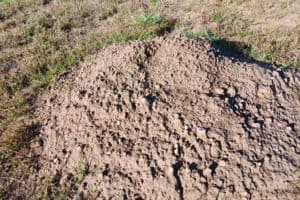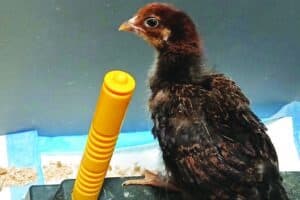Longtime local journalist Bill Radford and his wife, Margaret, live on 5 acres in the Falcon area with chickens, rabbits, dogs, cats, two noisy parrots, goats and two horses. Contact Bill at billradford3@gmail.com.
Thelma and Louise have not had easy lives.The two are hens that were rescued along with thousands of others from a neglect situation in Utah, all “battery chickens” confined to cages and essentially treated as egg-laying machines. We got our pair through a rescue effort that saw the hens find homes across several states.After some time in isolation, we introduced the two to our other chickens, and Thelma and Louise have long since comfortably settled in.But my wife, Margaret, recently noticed that Louise was not doing well. While Thelma was thriving, looking far removed from the thin, nearly featherless chicken we had adopted, Louise was still struggling. And while she seemed to be eating, she was not packing on the weight like Thelma. In fact, Louise seemed like just feathers and bones when Margaret picked her up.So it was to the vet for Louise. The vet took one look at Louise’s pale, drooping comb and knew she wasn’t well; an inspection soon produced a diagnosis: mites.Mites are parasites that can live on the outside of the chicken and feed on its blood. “A heavy mite infestation can lead to anemia and death of a chicken,” warns The Chicken Chick at the-chicken-chick.com. “Some of the common signs of any type of mite or lice infestation in a chicken are dirty-looking vent feathers, decreased activity or listlessness, a pale comb, change in appetite, a drop in egg production, weight loss, feather-pulling, bald spots, redness or scabs on the skin, ragged-looking feathers, crawling bugs on a chicken’s skin or nits on feathers.”What are you looking for exactly? Pestworld.org offers a description of chicken mites, and it’s not pretty: “Adult female†chicken mites†are small,†at only roughly 1/32 inch long. They have flat, oval bodies, and are nearly white when unfed, but become bright red when recently fed, turning gray to black when the blood meal is partially digested.†Chicken mites†are covered with tiny hairs across their back†and have long,†whip-like mouthparts.”A Colorado chicken owner posted a query to Ask an Expert at ask.extension.org wondering if mites were an issue in our state or if the higher altitude rid chicken owners of that threat. The answer: While mites might struggle to survive at very high altitudes, “mites and lice are still an issue here in Colorado, at least up and down the Front Range.”How to treat the problem? “A good natural treatment for mites and lice is to use fireplace ashes for your chickens to dust bath in,” the Ask an Expert answer went on to say. “We also recommend using Garden & Poultry Dust for treatment; there are other poultry spray treatments that also work. Treat by putting dust or sprays on the chicken and on the roosts, nesting boxes, everything. There are many other treatments for these parasites. If your birds have some dust bath areas, you can add a little dust to those areas. If they have leg mites, you can cover their legs with petroleum jelly, which prevents them from hatching and they then fall off.”As far as prevention, the site states, “Always keep your chicken coops clean and dry. Use dust like Garden & Poultry dust to prevent these parasites. Make sure your chickens have a place to dust bathe. Regularly check your chickens for these parasites (at night will be easier because you wonít have to catch them).”Our vet quickly sprang into action, with a shot that apparently repelled the mites (they were soon falling off and dying), antibiotics, vitamins and a de-wormer. Margaret was sent home with more vitamins to put into Louise’s water and more antibiotics to inject into her. We also dusted her with the afore-mentioned Garden & Poultry Dust and put her into isolation for several weeks; the other chickens got dusted as well.Interestingly, Louise likely has more risk of exposure to the gruesome little pests while living the good life as a backyard chicken than she did as a battery hen. A study reported on in Entomology Today found a much greater diversity of ectoparasites (mites and lice) was found on backyard chickens than has been reported in commercial flocks. One reason? Those housed in battery cages have “little contact with the ground or substrate that immature stages of parasites like fleas and some mites need to develop. In addition, these cages provide fewer crevices that might harbor ticks or bed bugs when they arenít feeding on birds.”The good news is that Louise seems to be feeling much better and is back with the flock. But if you’re feeling a little itchy after reading this, I understand. (FYI, from what I’ve read, the chicken mites will bite people but not infest them.)Pull quote: While mites might struggle to survive at very high altitudes, “mites and lice are still an issue here in Colorado, at least up and down the Front Range.”





